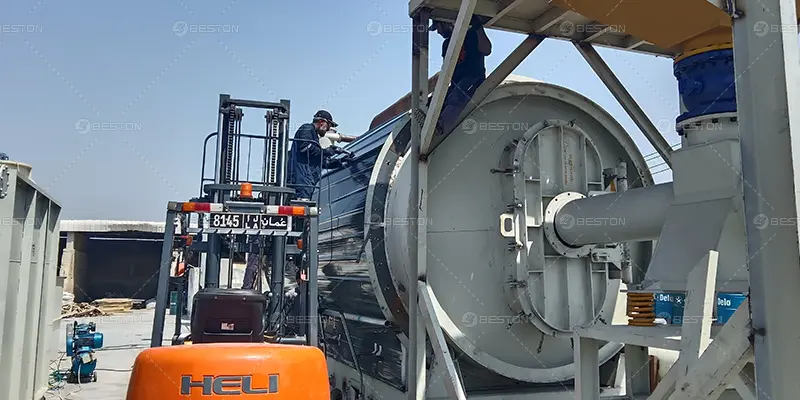Intermittent pyrolysis systems are increasingly recognized for their economic practicality in waste-to-energy applications. Unlike continuous setups that demand high initial investment and complex automation, these modular configurations offer a more balanced cost structure suited for small to medium-scale operations. Their economic advantage is derived not only from lower capital expenditure but also from simplified maintenance, adaptive throughput, and resource-efficient operation.
Lower Initial Capital Requirements
One of the most distinct financial advantages of a small pyrolysis machine lies in its moderate equipment cost. The modular nature of the system allows operators to deploy smaller units with fewer peripheral components, minimizing upfront financial commitment. Instead of requiring a large-scale facility and extensive auxiliary systems, intermittent models are compact, requiring limited land area and reduced infrastructure preparation. This characteristic makes them particularly suitable for decentralized waste management projects and emerging markets where investment capital is constrained.
The design simplicity also means fewer automation modules and control systems, leading to lower procurement and installation costs. For operators entering the sector or expanding cautiously, this financial flexibility is a decisive factor that supports gradual scaling rather than one-time, high-risk investment.

Optimized Operational Economics
While continuous pyrolysis systems achieve high productivity, their efficiency often comes at the pyrolysis plant cost of significant energy input and uninterrupted labor demand. Intermittent systems, by contrast, are optimized for cyclical operation. This intermittent heating and cooling process allows operators to align energy usage with feedstock availability, reducing idle-time losses and fuel consumption.
Energy balance is one of the most critical parameters affecting operational expenditure. Because intermittent systems operate in discrete cycles, they can integrate alternative heat sources, such as recovered syngas or biomass-derived fuels, during specific stages of operation. This adaptability enhances energy efficiency and lowers dependency on external power supply.
Maintenance costs are another notable factor. The batch-oriented process simplifies inspection and cleaning between runs, reducing mechanical wear and tear. As a result, the operational lifespan of core components—particularly the reactor and condenser—can be extended without frequent replacement or costly shutdowns.
Feedstock Flexibility and Material Efficiency
Intermittent pyrolysis machines are engineered to handle a diverse range of raw materials, from municipal solid waste to agricultural residues. This feedstock versatility directly influences the overall economic performance of the pyrolysis plant, as it enables operators to process locally available materials without extensive pre-treatment.
The ability to handle mixed or variable-quality input minimizes procurement costs and logistical complexities. In regions where waste composition fluctuates seasonally, intermittent systems outperform continuous lines by maintaining stable output quality despite inconsistent input. This operational resilience ensures a consistent yield of biochar, syngas, and bio-oil—three marketable products that collectively enhance return on investment.
Simplified Operation and Workforce Efficiency
Labor costs often constitute a significant portion of total plant expenditure. Intermittent units mitigate this burden through simplified control requirements and shorter operating shifts. Manual intervention, while still necessary for loading and unloading, is limited to defined process windows. This predictability allows for better workforce scheduling and minimizes overtime expenses.
Additionally, the reduced technical complexity translates to lower training costs and shorter commissioning time. For local operators or municipal bodies, this accessibility facilitates faster project deployment and reduces reliance on specialized technicians.
Environmental and Economic Synergy
Cost efficiency in intermittent pyrolysis extends beyond direct financial savings. The process inherently produces valuable by-products—particularly biochar—that can be commercialized in agriculture, construction, or carbon credit markets. This secondary revenue stream can offset a significant portion of operating expenses, further improving economic viability.
Moreover, the intermittent model allows for controlled emissions and easier compliance with environmental regulations. Lower exhaust gas volumes simplify gas treatment requirements, enabling the use of smaller-scale scrubbing or filtration systems. These design efficiencies reduce both environmental impact and equipment overhead.
Sustainable Economics for Emerging Applications
Intermittent pyrolysis technology bridges the gap between small-scale waste valorization and industrial-scale carbon reduction. By combining moderate investment needs with operational efficiency, it offers a sustainable economic pathway for communities and businesses aiming to convert waste into energy or carbon-rich products. Its balanced cost structure makes it a pragmatic choice for organizations seeking both profitability and environmental responsibility within a manageable financial framework.
In essence, the intermittent pyrolysis plant embodies a cost-conscious evolution of thermal conversion technology—streamlined, adaptable, and strategically efficient in transforming waste streams into enduring economic and ecological value.
Comments
No comments yet. Be the first to react!